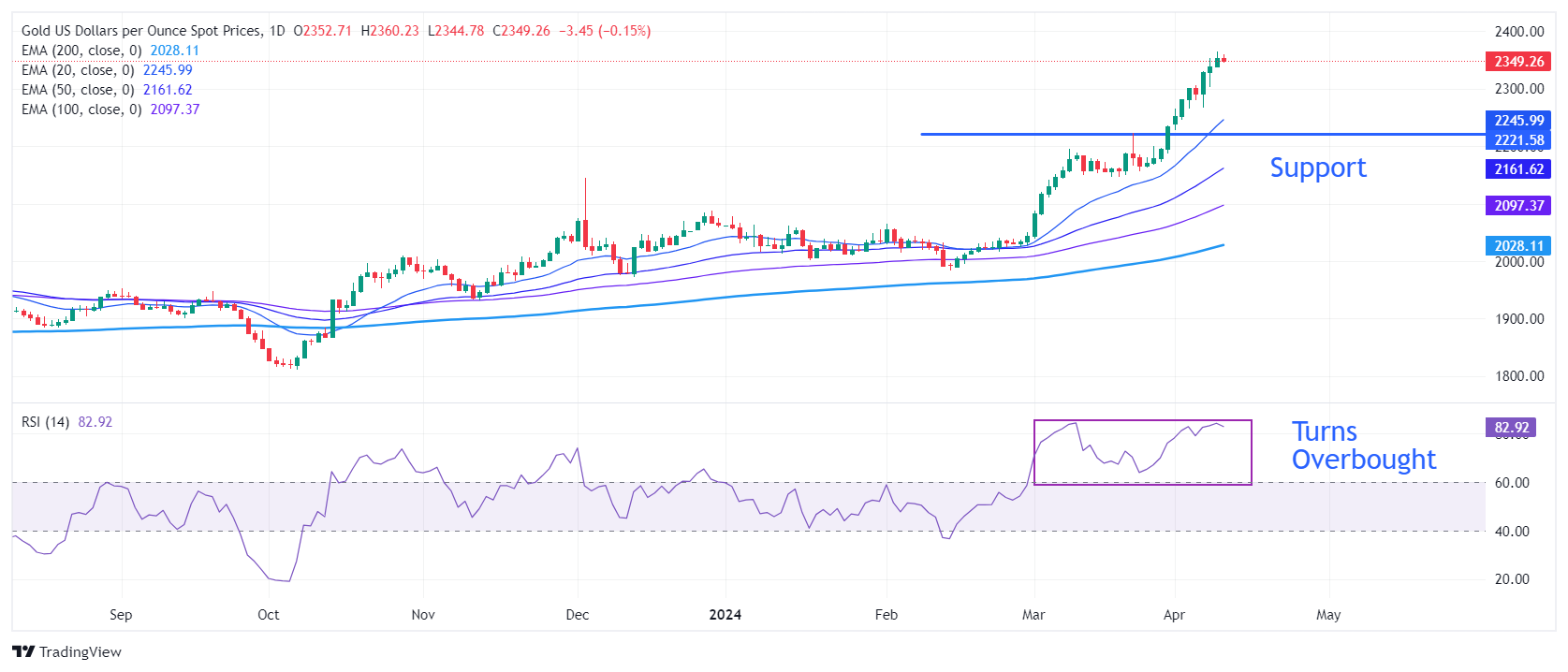Gold slumps from fresh highs as hot US Inflation dents Fed rate cut hopes

- Gold price faces an intense sell-off on hot US inflation data for March.
- The US monthly headline and core CPI grew steadily by 0.4%.
- Escalating geopolitical tensions keeps the demand for Gold intact.
Gold price (XAU/USD) falls sharply from fresh highs of $2,365 in Wednesday’s early New York session as the United States Bureau of Labor Statistics (BLS) has reported a stubbornly higher Consumer Price Index (CPI) report for March. The inflation grew steadily on major parameters, while annual headline inflation accelerated further to 3.5% from expectations of 3.4% and the prior reading of 3.2%. Economists anticipated inflation to remain stubborn due to higher Oil prices, rentals, insurance costs and portfolio management fees.
Strong CPI data forced traders to shift bets on the Federal Reserve (Fed) beginning to reduce interest rates from the September meeting. This scenario bodes well for interest-bearing assets, such as US bonds and the US Dollar. 10-year US Treasury yields soar to 4.5%. The US Dollar Index (DXY), which values the US Dollar’s strength against six major currencies, rallies to 105.00. Hotter-than-expected is expected to deepen uncertainty over the number of rate cuts by the Federal Reserve (Fed), which policymakers anticipated three times this year.
Generally, the Fed’s longer-term maintenance of higher interest rates builds downside pressure on non-yielding assets such as Gold as it increases the cost of investing in them. Still, there has been an anomaly in Gold in the past few weeks, as its demand remained robust despite traders paring big bets on Fed rate cut prospects for the June and July meetings.
Daily digest market movers: Gold price falls sharply while US Dollar rallies
- Gold price drops vertically from fresh all-time highs of around $2,365 due to multiple headwinds. Stubbornly higher United States inflation data for March and strong payroll data combined with overbought momentum oscillators have put significant pressure on the Gold price. This has shaken investors’ confidence in the Federal Reserve reducing interest rates in the June and July policy meetings.
- US monthly headline and core CPI, which strips off volatile food and energy prices, both grew steadily by 0.4%. Economists forecasted them to grow slowly by 0.3%. The annual headline inflation rose strongly by 3.5% from expectations of 3.4% and the prior reading of 3.2%. The annual core inflation increased steadily by 3.8%. Investors anticipated it to decelerate slightly to 3.7%.
- Earlier, the precious metal has experienced a great bull run in the last few weeks. Gold has remained the talk of the town in the past few weeks due to a fresh escalation in Middle East tensions, which has firmed safe-haven bids and pent-up demand for precious metals by global central banks. Central banks piled up Gold inventory as a hedge against a potential economic slowdown.
- Fading expectations of a ceasefire between Israel and Palestine also keep Gold demand buoyant. The Israeli proposal of a ceasefire on April 9 didn’t match the demands from Hamas, which wants Israel to withdraw its forces and allow displaced Palestinians to return to their homes.
Technical Analysis: Gold price retreats from fresh highs around $2,360
Gold price falls sharply as the US inflation data turns out hot. The precious metal hovers near fresh lifetime highs around $2,360. The near-term demand remains intact as all short-to-long-term Exponential Moving Averages (EMAs) are still sloping higher.
On the downside, March 21 high at $2,223 will be a major support area for the Gold price bulls.
The 14-period Relative Strength Index (RSI) reaches 85.00, indicating a strong bullish momentum. However, extremely overbought signals could lead to a mild correction.
Fed FAQs
Monetary policy in the US is shaped by the Federal Reserve (Fed). The Fed has two mandates: to achieve price stability and foster full employment. Its primary tool to achieve these goals is by adjusting interest rates. When prices are rising too quickly and inflation is above the Fed’s 2% target, it raises interest rates, increasing borrowing costs throughout the economy. This results in a stronger US Dollar (USD) as it makes the US a more attractive place for international investors to park their money. When inflation falls below 2% or the Unemployment Rate is too high, the Fed may lower interest rates to encourage borrowing, which weighs on the Greenback.
The Federal Reserve (Fed) holds eight policy meetings a year, where the Federal Open Market Committee (FOMC) assesses economic conditions and makes monetary policy decisions. The FOMC is attended by twelve Fed officials – the seven members of the Board of Governors, the president of the Federal Reserve Bank of New York, and four of the remaining eleven regional Reserve Bank presidents, who serve one-year terms on a rotating basis.
In extreme situations, the Federal Reserve may resort to a policy named Quantitative Easing (QE). QE is the process by which the Fed substantially increases the flow of credit in a stuck financial system. It is a non-standard policy measure used during crises or when inflation is extremely low. It was the Fed’s weapon of choice during the Great Financial Crisis in 2008. It involves the Fed printing more Dollars and using them to buy high grade bonds from financial institutions. QE usually weakens the US Dollar.
Quantitative tightening (QT) is the reverse process of QE, whereby the Federal Reserve stops buying bonds from financial institutions and does not reinvest the principal from the bonds it holds maturing, to purchase new bonds. It is usually positive for the value of the US Dollar.
